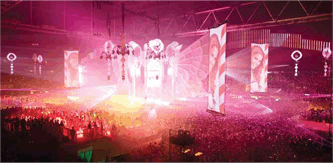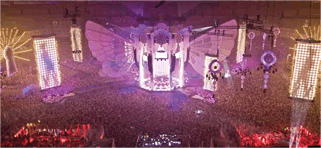Inside the 58-Motor System Designed for Amsterdam Dance Spectacular’s 10th Birthday
Sensation celebrated its 10th Anniversary with a “Wicked Wonderland” theme in a two-night, sold-out dance party at the Amsterdam Arena.
Sensation, one of Europe’s top dance event brands, celebrated its 10th anniversary with this year’s “Wicked Wonderland” theme, as its organizers took the production concept another step further, creating an immersive party atmosphere over two sold-out nights at the Amsterdam Arena.
Since 2001, Sensation’s 35,000-pernight crowd has followed an all-white dress code, originally a tribute by organizer Duncan Sutterheim to his late brother Miles, who was given an all-white funeral in 2000. The tradition has continued, and this year’s human snowscape was reflected in specially commissioned white aerial décor, props, and lighting effects.
The aerial pieces were animated, along with video screens and lighting pods, by a 58-motor XLNT CyberHoist motion control system, controlled by a complex four-zoned Ethernet system using XLNT Advanced Technologies DN2 Ethernet/DMX nodes and NS12PF Ethernet/Fiber Optic switches, all provided by Flashlight. Sensation creative director Sander Vermeulen says, “The whole atmosphere, the lighting and flown pieces, really hits you when you walk in and see 35,000 people all dressed in white.”
He adds, “We wanted to make it more intimate this year, so you don’t feel you’re in a super-size stadium, much more like a big club. We achieved the intimacy by breaking up the scene with large video screens and special visuals like floating keys and expanding butterfly wings, so that if you walk 10 meters in any direction, you have a totally different picture because there’s a lot of depth in the design.”
A new feature was a central tower of closed white drapes that, one hour in, opened under CyberHoist control to reveal a central stage, followed after another hour by the unfolding a giant pair of inflatable butterfly wings -- white, of course. Says Vermeulen, “It was a metaphor for changing the mood of the evening, and it was also the biggest technical challenge.” The wings had been suspended in a large sack high out of sight, then descended on a pair of CyberHoist CH250 250kg motors and unfolded via a monorail system as they were inflated.

The 58 active CyberHoists, eight of which were 250-kilogram CH250 motors with another 50 500-kilogram CH500s, were controlled on two XLNT InMotion3D systems.
Twelve hanging “keys” pirouetted under CyberHoist control, each internally lit with six moving heads, three Atomics as audience blinders, and each carrying an external Showgun effect light and four Fire Jet pyros. Lighting circles and a pair of “moons” were also part of the animated aerial action.
CyberHoists also raised and lowered eight giant MiTrix LED video panels with two motors per screen, as well as providing the final visual ingredient -- four flying “butterfly girls” and another who “grew” like Alice herself in a dress that expanded from human size to a towering 10m high and 6m wide.
The 58 active CyberHoists, eight of which were 250-kilogram CH250 motors with another 50 500-kilogram CH500s, were controlled on two XLNT InMotion3D systems, with the center stage elements on an Apple-based PS Production System and the aerial acts and keys -- 34 hoists in all -- on an Apple-based FPS Full Production System.
The four power and network cable management zones were connected via Ethernet by up to 270 meters of fiber and E-stop to the FOH position, where a total of 14 XLNT Ethernet switches divided the network into the two control systems and XLNT E-stop combiners merged the power distros to three separate E-stop resets for maximum safety and electrical isolation.
The show was triggered by DMX from a Medialon server running timecode, converted by XLNT DMXlink dual-channel DMX TriggerBoxes to triggers for the chain hoist manager.
Sander Vermeulen was creative director and Marcel Elbertse production director for Sensation, with lighting designer Gerard Maijenburg. The motion control team consisted of Flashlight’s CyberHoist project manager Arjen Hofma, acts and keys operator Ramon Rijsdijk, screens and butterflies operator Sander Buys, and CyberHoist engineer Mario Reijm.
